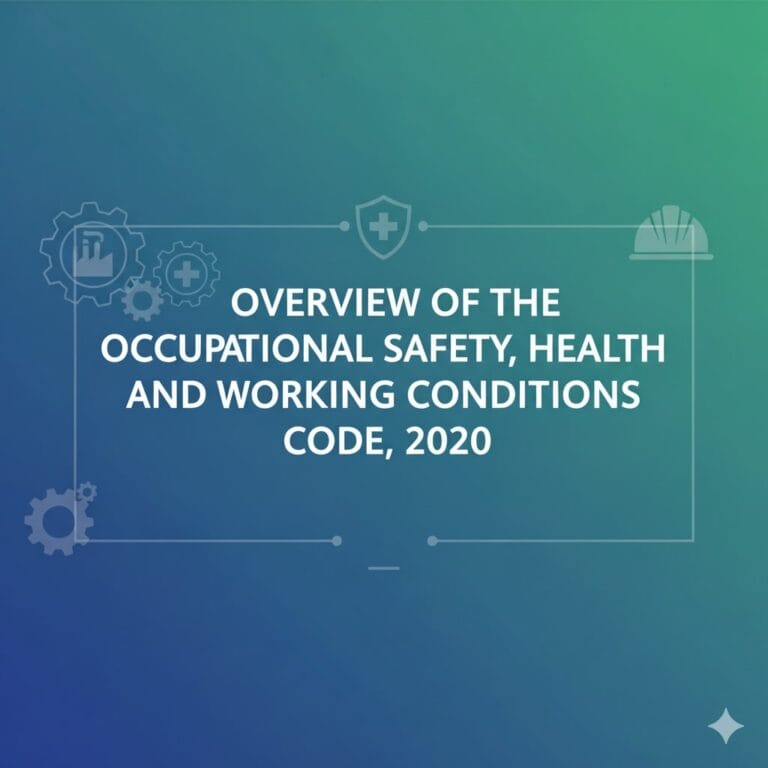
Background
The Code has been enacted by the Parliament with the purpose of consolidating and reforming the statutes regulating occupational safety, health, welfare and working conditions of persons employed in various establishments. Prior to the Code, multiple sector-specific enactments governed factories, mines, construction, plantations, contract labour, inter-state migrants, journalists and other specialised work-forces. Over time these laws, while important, became fragmented, overlapping, and burdened by multiple registrations, licences, returns and inspection regimes.
The need for the Code emerged in light of rapidly evolving employment patterns, expansion of the service and informal sectors, technological and organisational change, and frequent workplace hazards. By bringing together the relevant provisions into one unified statute, the Code aims to promote clarity, uniformity and ease of compliance, while safeguarding workers’ rights to health, safety and decent working conditions.
Extent and Commencement
The Code extends to the whole of India and shall come into force on such date or dates as the Central Government may, by notification, appoint. Different provisions may be brought into force at different times. The following Act of Parliament received the assent of the President on the 28th September, 2020.
Acts Consolidated Under the Code
The Code subsumes the following major central statutes:
Key Provisions
Registration and Licence. Every establishment to which this Code applies shall, within sixty days of its commencement or as may be notified, register itself electronically with the registering officer appointed under this Code. Where an establishment is engaged in processes or activities prescribed under this Code, the employer shall further obtain a licence in such form and subject to such conditions as may be prescribed.
Duties of Employers. The employer of an establishment shall ensure that the workplace is free from hazards likely to cause injury or occupational disease; machinery, plant, articles and substances used in the establishment are maintained in safe condition; periodic health-examinations of employees in notified categories are conducted free of cost; hazardous and toxic waste (including e-waste) is safely disposed of; written appointment letters are issued to all employees at the time of engagement; and welfare facilities prescribed in respect of drinking water, sanitation, ventilation, illumination, creche, locker rooms and other amenities are provided and maintained.
Working Hours and Leave. No worker shall be required to work for more than eight hours in any day or for more than forty-eight hours in any week, save as may be permitted by this Code or the rules made thereunder. Overtime shall be paid at double the rate of wages for the overtime hours worked. A worker who has worked for a period of not less than one hundred eighty days in a year shall be entitled to leave with wages at the rate of one day for every twenty days of work. Women workers may be employed in night shifts with their written consent and subject to such conditions as may be prescribed.
Inter-State Migrant Workers.
Contract Labour
Provisions for Women Workers:
The Code allows women to work between 7 p.m. and 6 a.m. with their consent, subject to safety and transportation arrangements provided by the employer.
Accident and Disease Reporting:
Employers must notify the authorities in case of any accident causing death, serious injury, or occupational disease within the prescribed time and manner.
Ease of Doing Business
Through the adoption of digital registrations, risk-based inspections, and a single compliance platform, the Code simplifies processes and aligns with the government’s objective of improving the business environment while safeguarding labour rights.
Welfare Facilities:
In establishments specified under the First Schedule:
A welfare officer to be appointed by the employer if the establishment has 250 or more employees
Institutional Mechanism
The Central Government shall constitute a National Occupational Safety and Health Advisory Board comprising representatives of the Central Government, State Governments, employers and workers. The State Governments shall constitute similar State-level Boards. Where required, the appropriate government may direct the constitution of safety committees in specified establishments, comprising equal or greater representation of worker representatives over employer representatives, to foster bipartite dialogue and strengthen internal safety culture.
Penalties and Offences
Any person guilty of obstructing an Inspector or otherwise contravening the provisions of this Code shall be punishable with imprisonment for a term which may extend to three months and a fine which may extend to one lakh rupees. If any contravention results in the death of a worker, the offender shall be punishable with imprisonment which may extend to two years or with fine which may extend to five lakh rupees, or with both. Corporate bodies shall be liable in respect of offences committed by their officers in default.
Conclusion
The Occupational Safety, Health and Working Conditions Code, 2020 constitutes a landmark reform in India’s labour law architecture. By replacing a labyrinth of sector-specific statutes with one modern, comprehensive and coherent statute, it sets the foundation for improved occupational safety, uniform working-conditions, enhanced welfare facilities and streamlined compliance for employers. While effective implementation and state adoption of rules remain crucial, the legislative framework now provides a clear pathway for safer workplaces, greater employer accountability and integrated industrial growth.
Disclaimer: The information contained in this Article is intended solely for personal non-commercial use of the user who accepts full responsibility of its use. The information in the article is general in nature and should not be considered to be legal, tax, accounting, consulting or any other professional advice. We make no representation or warranty of any kind, express or implied regarding the accuracy, adequacy, reliability or completeness of any information on our page/article.